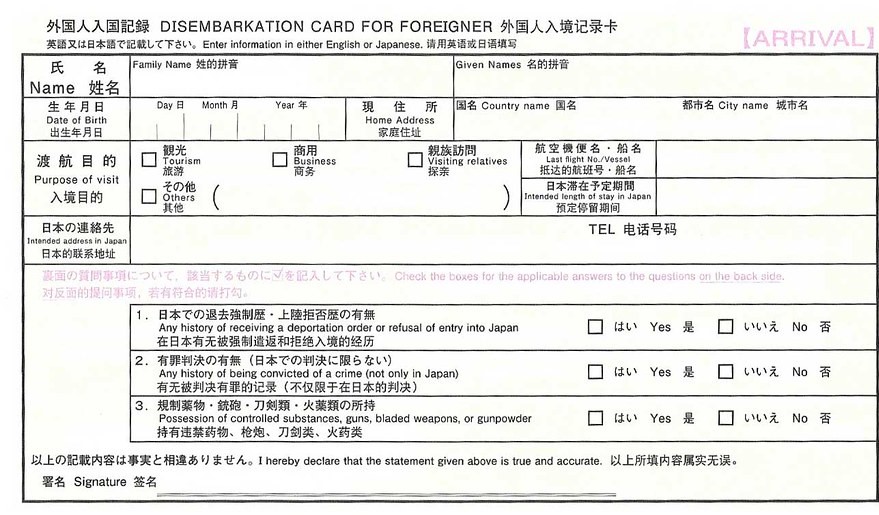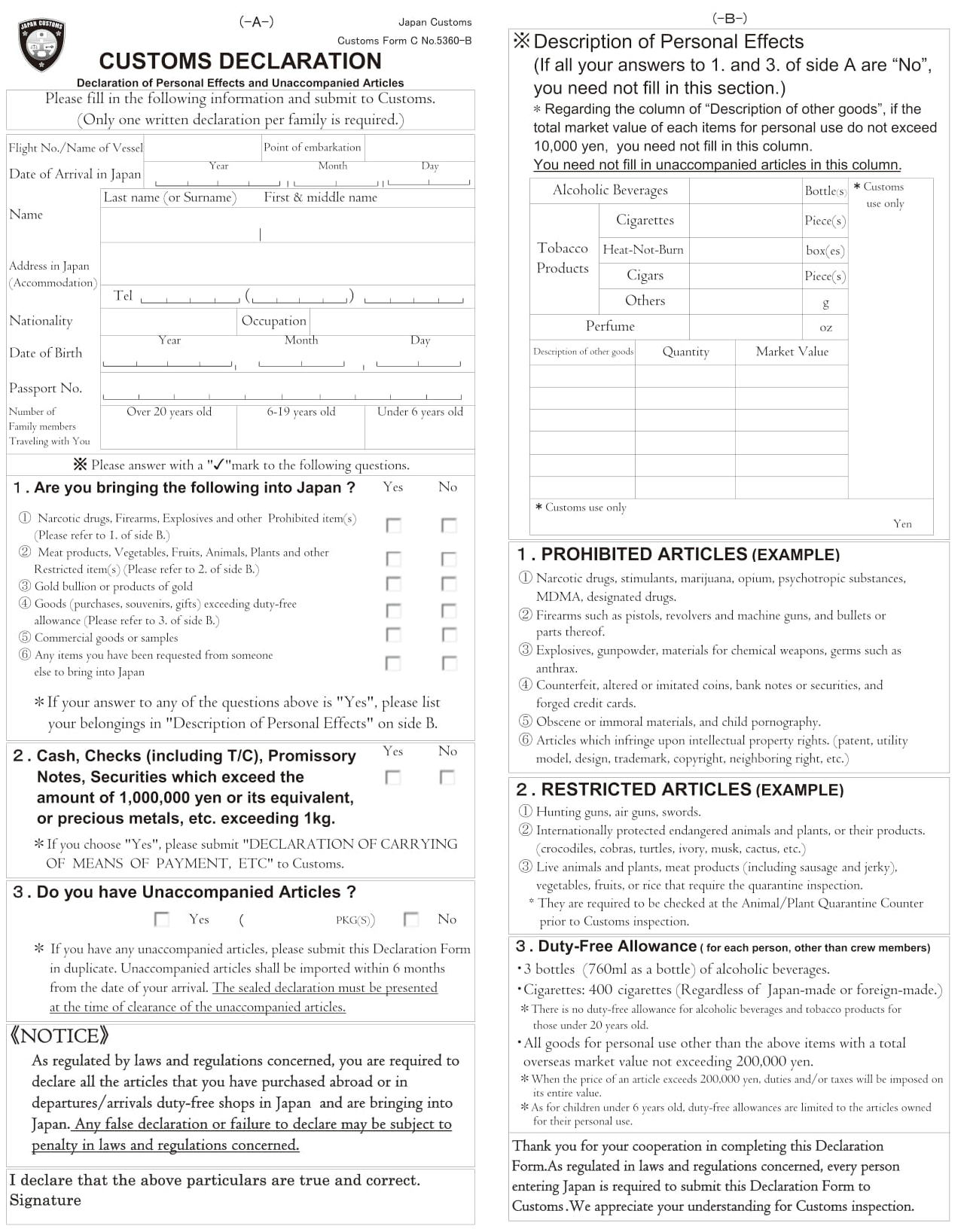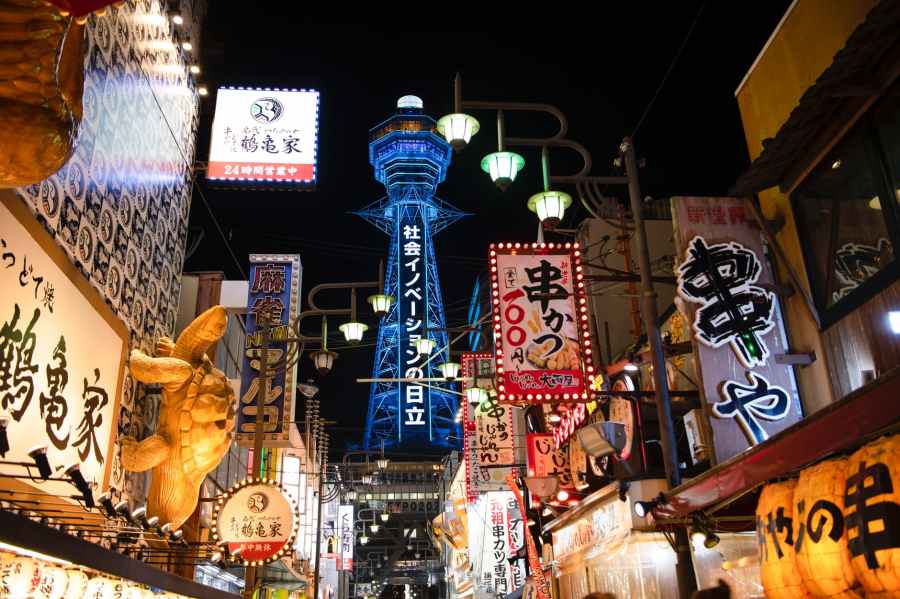Back in… 2014 (?!) I did a blog series called “So You’ve Landed in Japan.” One of the posts ended up turning into my most popular post on this entire blog. The post is with regards to Customs and Immigration and discussed the procedures a traveler faces when entering Japan from another international destination.
Looking back on that post, I feel as if the title of the post was a little misleading. Most of the comments on the post were specific questions about immigration status, visa inquiries, and that sort of thing. This blog is meant to offer advice on travel to Japan, but in no way am I qualified to handle specific immigration questions.
Based on this, and because arrival procedures and forms have changed in recent years, I’ve decided to renew this post and title it, more appropriately, Arrival Procedures.
At the outset, I wish to reiterate that if you have any specific questions about Japanese immigration or visas, please contact your local Japanese embassy or consulate. I will discuss this information in a very broad scope (as I did in the previous post) but, again, I am not equipped to answer specific questions on this. A great resource is on the web site of Japan’s Ministry of Foreign Affairs. The link to all of their consulates and embassies can be found here. Please contact them for all of your specific inquiries. I’ve updated the site-wide disclaimer with this information as well.
Prerequisites
Of course, before visiting Japan, you will need a Passport and, in certain circumstances, you will also need a visa. People visiting Japan from 68 countries and regions do not require a visa if visiting as a tourist, or if visiting relatives, attending conferences, etc. All but four of these are eligible for visa exemptions of 90 days. If you are engaging in paid work in Japan, or if you will be staying in the country longer than the amount of time granted for a visa exemption, you will have to apply for a visa.
The Ministry of Foreign Affairs maintains a list of countries and regions eligible for visa exemptions.
Forms to fill out
Many international travelers are used to filling out immigration and/or customs forms to be submitted upon arrival to wherever they are going. Many countries are starting to phase out physical paperwork in favor of automatic kiosks. Japan, with some exceptions, still uses paperwork.
Visitors to Japan typically fill out two or three different forms prior to their arrival.
- All visitors fill out a disembarkation form for immigration (one per person) and a customs form (one per family).
- If you are bringing pets or plant/animal products into Japan, you will have to fill out a quarantine form. Visitors from certain parts of the world with health concerns may also have to fill out a quarantine form or questionnaire.
Unlike countries where one entity handles all entry procedures (such as Customs and Border Protection in the United States), Japan has separate ones:
- Pet, Animal and Plant Quarantine is under the Ministry of Agriculture, Forestry and Fisheries
- Health Quarantine is under the Ministry of Health, Labour and Welfare
- Immigration had been its own ministry until 2019, and is now under the Ministry of Justice
- Customs is under the Ministry of Finance (which includes the Customs and Tariff Bureau).
Disembarkation Form (Immigration)
 Shown here is a photo of the new disembarkation card that Japan has been using since 2016. Each passenger should fill out their own disembarkation card.
Shown here is a photo of the new disembarkation card that Japan has been using since 2016. Each passenger should fill out their own disembarkation card.
Let’s go through each of the steps to fill out.
Fill out your family name and given names as they are listed on your passport, your date of birth (in the form of day, month and year) and the country and city where you currently reside. You do not need to enter a passport number, gender or nationality, which was the case with previous versions of the form.
Check the box next to the purpose of your visit. Most visitors will select the box for tourists.
Next to this, you’ll see Last Flight No./Vessel. Write down the flight number (or vessel if you arrive by boat) that you used to enter Japan. For example, if you were flying into Japan on United Airlines Flight 79 from Newark, New Jersey, you’d write down either United 79 or UA 79 in this box.
Below this, write down the number of days you plan to stay in Japan.
The next field asks for your intended address in Japan. The rule of thumb I’ve always used is to enter the first location that you plan to stay in when visiting the country. If you will go from the airport to a friend’s residence, enter their residence here and their telephone number. Otherwise, if you are going to a hotel, enter the hotel name, address and telephone number as best as you can. Even if you are staying in multiple locations, just write down the first one you will be using.
The last few questions must be asked to comply with the laws of Japan, so you have to answer them:
- Have you ever been deported or refused entry into Japan?
- Have you ever been convicted of a crime in Japan or another country?
- Are you in possession of controlled substances, guns, bladed weapons or gunpowder?
Sign your disembarkation form, and that’s it!
Customs Form
 Here is a photo of form C5360-B, otherwise known as the Declaration of Personal Effects and Unaccompanied Articles, or the Customs Declaration. Note that this is a double-sided form; both sides are shown here.
Here is a photo of form C5360-B, otherwise known as the Declaration of Personal Effects and Unaccompanied Articles, or the Customs Declaration. Note that this is a double-sided form; both sides are shown here.
Here you will fill out some of the same details you entered on the immigration form, plus a few other particulars.
In addition to your flight or vessel number, you will need to write down the point of embarkation, or in other words, the location you departed from to enter Japan. For our example of United Flight 79, you’d write down Newark.
Here you must also enter your nationality, occupation, passport, and number of family members traveling with you. Remember that one customs declaration can be submitted per family.
Next, answer the questions about articles you are bringing into Japan. Follow the instructions to declare this information on the back of the form if necessary.
The back of the form will include the duty-free allowance per person for items being brought into Japan, along with a list of prohibited and restricted articles.
Once you have completed the form, all that’s left to do is to sign it.
Quarantine Form
If you are entering Japan with pets, or with plant/animal products, you will have to fill out specific quarantine forms. Please visit the website of the Ministry of Agriculture, Forestry and Fisheries for more information on this type of quarantine.
Depending on health circumstances, some visitors may also be asked to fill out a health quarantine form or questionnaire. This varies depending on the situation. For example, as of this post (25 February 2020) there are concerns about the coronavirus outbreak, and some information published by the Japanese Embassy in New York suggests that quarantine forms are being circulated asking passengers if they have visited, or plan to visit, certain regions of China within 14 days of their arrival into Japan.
Entry Procedures
Now that all of the paperwork is done, let’s look into the steps of arriving into Japan.
When you step off of a plane or boat, your entry procedures will follow these basic steps:
- Health Quarantine
- Immigration
- Baggage Claim
- Pet / Animal / Plant Quarantine
- Customs
The first step is health quarantine. Most passengers entering Japan will walk by an infrared scanner which checks your body temperature. If a quarantine officer notices anything amiss, you will be asked to enter the health consultation room and speak to a doctor. You can also voluntarily check in to this room if you feel sick or unwell for any reason. If you were handed a health quarantine form/questionnaire, you will probably be asked to submit it here.
Immigration is the next step. Step up when you are called, one person at a time, to the immigration officer. Submit your passport, your disembarkation form, and your visa if required. The immigration officer will check your documents, take your photo and collect your fingerprints. You might also be asked a few questions to determine your entry status. The officer will then stamp your passport and you can then proceed to baggage claim to collect your checked belongings. Note that in a few locations, you might be checked by a clerk before you arrive at the immigration desk to take your photograph and fingerprints… this happened to me at Narita during my last trip in 2017.
If you have pets, or plant/animal products, this is the point where you will check in to the respective quarantine desk to handle those procedures.
The last step is to go to customs. As with most countries, there will be a green channel if you have nothing to declare or within duty-free exemptions, and a red channel if you have items to declare or if you are not sure. Whatever the case, you will speak to another manned officer at customs. Here the officer will check your passport and review your customs declaration. Remember, customs has the right to search your belongings to ensure there are no prohibited or restricted articles. The officer may ask you some questions, such as where you are from, and if you have any items to declare. One time, I was asked about my precise itinerary when I was in the country. There is a cashier nearby if you need to pay any duty.
If you are in doubt about anything that you are bringing into Japan, visit the red channel.

On a side note, do remember that Japan has strict laws with regard to certain drugs and medications, as the above graphic from the U.S. Department of State indicates. For example, stimulants cannot be brought into Japan under any circumstances. Visitors to Japan may not be aware that certain over-the-counter or behind-the-counter medications use to treat pain, decongestion, cold/flu, ADHD and depression cannot be brought in to Japan. So leave your Sudafed, Actifed, NyQuil and Vicks inhalers at home, and don’t bring medicine containing things such as codeine, pseudoephedrine, phenylephrine, dexamphetamine or anything with HCl (hydrochloride) in the name. Also, even though marijuana and CBD/THC oils are gaining popularity in a lot of places, these are also illegal in Japan. You could be detained by Customs (or worse) if you are caught with these drugs and medications.
Certain prescription medications may also have to be declared in advance… please consult your local Japanese embassy or consulate for more information. Alternatively, you can e-mail your inquiries directly to the Japanese government at this e-mail: yakkan@mhlw.go.jp.
You’ve arrived!
Congratulations, and welcome to Japan!
There are just a few more things you may want to be aware about when it comes to arrival procedures:
International Transit
If you are landing in an airport in Japan for the purpose of changing to another international flight, and you do not plan to leave the airport, you do not need to go through immigration and customs procedures in Japan. All that is required is another security check. Remember the restrictions on liquids… if you have any duty-free liquids on your person that are not in tamper evident bags, they will be confiscated at the transit security checkpoint.
If you are a connecting to a domestic flight, or if you are changing from one airport to another (i.e changing from a flight landing at Narita to a flight departing from Haneda), you’ll need to undergo customs and immigration.
Automated Immigration Kiosk
Japan’s major ports of entry (i.e. the major airports) have automated kiosks for entry into Japan. However, while major countries have some kind of automatic kiosks in place, Japan’s kiosks are not available for all foreigners. You must enroll in a special trusted traveler program and meet specific requirements, one of which states that you must have visited Japan at least twice in the last twelve months. Aside from this, only Japanese nationals and foreigners residing in Japan currently qualify to use the automated kiosks.
Videos on Arrival Procedures
Japan Airlines has some links on their website to videos about arrival procedures for JAL flights into Japan’s four major international airports of Haneda, Narita, Chubu Centrair and Kansai. Visit JAL’s excellent Guide to Japan, and from that page, click on “More Fun”, select “Travel Information” and scroll down to the Immigration Guidance section. Just don’t mind the (rather catchy) elevator music.
UPDATE April 3, 2020: Japan Airlines has recently updated their website, so the above link to the immigration guidance videos MIGHT be going away soon.
I hope this post answers your questions about arrival procedures in Japan.
Once again, if you have any detailed questions about immigration, customs, visas, etc., please contact your local Japanese embassy or consulate. Such questions will NOT be answered on this blog.
This article was written in February 2020 and is accurate at the time of publication, subject to the site-wide disclaimer.
Images of Japanese immigration and customs documentation are public domain pursuant to Article 13(ii) of the Copyright Law of Japan.
The graphic about prohibited drugs in Japan is from the United States Department of State and is public domain pursuant to Title 17, Section 105 of the United States Code.


 Shown here is a photo of the new disembarkation card that Japan has been using since 2016. Each passenger should fill out their own disembarkation card.
Shown here is a photo of the new disembarkation card that Japan has been using since 2016. Each passenger should fill out their own disembarkation card. Here is a photo of form C5360-B, otherwise known as the Declaration of Personal Effects and Unaccompanied Articles, or the Customs Declaration. Note that this is a double-sided form; both sides are shown here.
Here is a photo of form C5360-B, otherwise known as the Declaration of Personal Effects and Unaccompanied Articles, or the Customs Declaration. Note that this is a double-sided form; both sides are shown here.